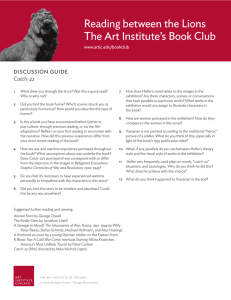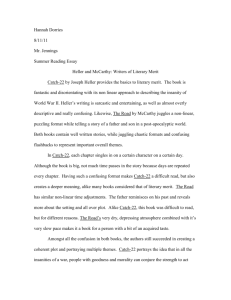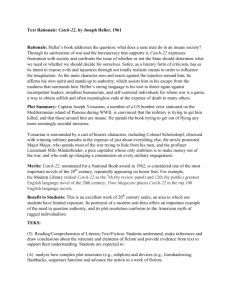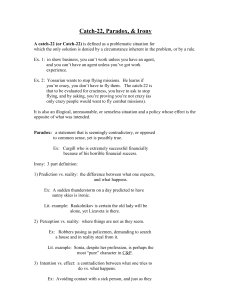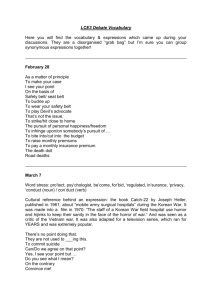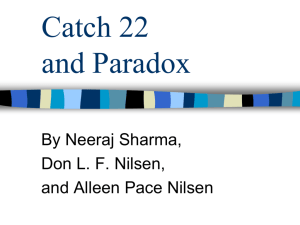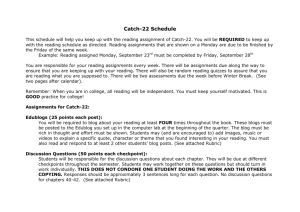Catch-22 Paper - WordPress.com
advertisement
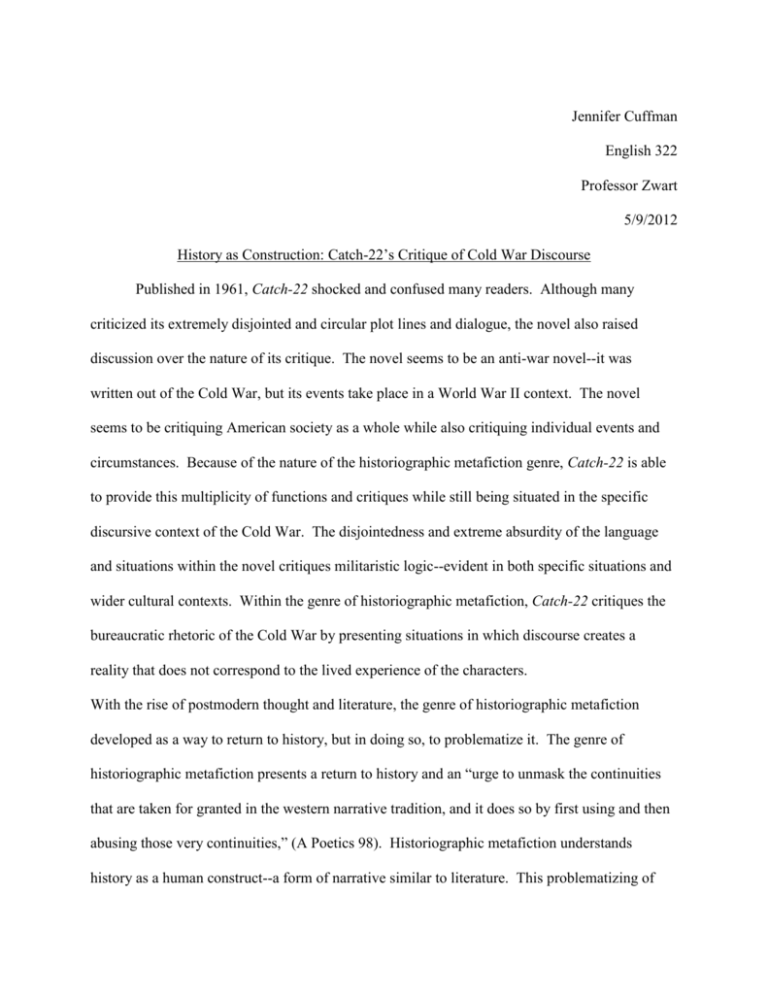
Jennifer Cuffman English 322 Professor Zwart 5/9/2012 History as Construction: Catch-22’s Critique of Cold War Discourse Published in 1961, Catch-22 shocked and confused many readers. Although many criticized its extremely disjointed and circular plot lines and dialogue, the novel also raised discussion over the nature of its critique. The novel seems to be an anti-war novel--it was written out of the Cold War, but its events take place in a World War II context. The novel seems to be critiquing American society as a whole while also critiquing individual events and circumstances. Because of the nature of the historiographic metafiction genre, Catch-22 is able to provide this multiplicity of functions and critiques while still being situated in the specific discursive context of the Cold War. The disjointedness and extreme absurdity of the language and situations within the novel critiques militaristic logic--evident in both specific situations and wider cultural contexts. Within the genre of historiographic metafiction, Catch-22 critiques the bureaucratic rhetoric of the Cold War by presenting situations in which discourse creates a reality that does not correspond to the lived experience of the characters. With the rise of postmodern thought and literature, the genre of historiographic metafiction developed as a way to return to history, but in doing so, to problematize it. The genre of historiographic metafiction presents a return to history and an “urge to unmask the continuities that are taken for granted in the western narrative tradition, and it does so by first using and then abusing those very continuities,” (A Poetics 98). Historiographic metafiction understands history as a human construct--a form of narrative similar to literature. This problematizing of history is not a rejection of actual events, but it is concerned with the construction of what is said about the events (A Poetics 99). According to Linda Hutcheon, “Historiographic metafiction accepts this philosophically realist view of the past and then proceeds to confront it with an antirealist one that suggests that, however true that independence may be, nevertheless the past exists for us--now--only as traces on and in the present (Politics 73). As Hayden White articulates, the narrativization of events will always reflect the concerns and biases of the historian; historiographic metafiction deconstructs the idea that one can ever write a truly objective history (Juan-Navarro). Because individuals are disconnected from events as they actually happened, historiographic metafiction examines they way that History is a constructed narrative that may or may not reflect actual events. This problematizing of History and Knowledge becomes one of the major themes in Catch-22 by critiquing the way that bureaucratic discourse, specifically through official documentation, establishes realities of absence and presence that are in contradiction to the reality of the character’s experience. The two characters that fall prey to these constructed realities are Doc Daneeka and Mudd. Because Doc Daneeka’s name was on the flight record of a plane that crashed, he is established as ‘dead’ although he is physically present to futilely refute the claim. Although Sergeant Towser is very aware of Doc Daneeka’s physical presence, he abides by the ‘fact’ of the official document: [W]ith lips still quivering, he rose and trudged outside reluctantly to break the bad news to Gus and Wes, discreetly avoiding any conversation with Doc Daneeka himself...Now he had two dead men on his hands--Mudd, the dead man in Yossarian’s tent who wasn’t even there, and Doc Daneeka, the new dead man in the squadron, who most certainly was there and gave every indication of proving a still thornier administrative problem for him. (Heller 339) In speaking to Doc Daneeka, one soldiers remarks, “The records show that you were in McWatt’s plane to collect some flight time. You didn’t come down in a parachute, so you must have been killed in the crash” (Heller 341). In this instance, official record defines reality and takes precedence over perception; Doc Daneeka‘s “death” may only be in the official record, however, this official record is a presentation of Knowledge. The complementary scenario in which presence is created in spite of death is in the involvement of Mudd. Although Mudd died before he actually got to base, he is treated as though he is still alive--his possessions even remain in Yossarian’s tent as though he lives there. The novel comments (perhaps tongue-in-cheek) on this situation: “The dead man in Yossarian’s tent was a pest, and Yossairan didn’t like him, even though he had never seen him. Having him lying around all day annoyed Yossarian so much that he had gone...to complain to Sergeant Towser” (Heller 22). Even though Yossarian has immediate perceptual access to the absence of Mudd, the official discourse of the bureaucracy creates a reality that encompasses the whole base. Christopher MacGowan comments that, “An official form can state that a man is dead even if the man himself is present to confirm that he is living...or that a man is alive even though everyone in the camp knows that he was killed before officially reporting for duty...[T]he system’s confirmation process taking on an autonomous authority of its own that is impossible to deny with mere facts.” (MacGowan 282). These situations of constructed presence and absence demonstrate how “symbolic forms and expressions have the privileged status according to ‘reality’” (Davis 64). Documented bureaucratic rhetoric is given a privileged position in shaping Catch-22’s reality, although it does not correspond to lived experience. In showing the disconnect between ‘official history’ and the actual events, Catch-22 (within the genre of historiographic metafiction) is able to comment on the traditional means of creating and thinking about history as created by artifacts or official documentation. Similarly to realities created through the elevation of official documentation to ‘fact’ and ‘history’, Catch-22 also demonstrates how ideological realities are formed--apart from material or written words. The concept of Catch-22 is one such ideology. In the book, the rhetoric of Catch-22 is used in many different ways, but each time it is used in a way that keeps the soldiers trapped within its paradoxical language. The novel remarks, “Catch-22 did not exist, [Yossarian] was positive of that, but it made no difference. What did matter was that everyone thought it existed, and that was much worse, for there was no object or text to ridicule or refute, to accuse, to criticize, attack, amend, hate, revile, spit at, rip to shreds, trample upon or burn up” (Heller 407). Yossarian’s insights display the way that discourse and realities formed apart from materials and official documents can be more powerful than the type of realities formed by documented discourse--such as the ‘death’ of Doc Daneeka. While the reality formed around Daneeka is quite affective in the novel, he still has the potential to refute the ‘fact‘ through his bodily presence. Clevinger’s trial presents another instance of the constructed realities of the Air Corps apart from any official evidence. Clevinger is put on trial after he “stumbled while marching to class” (Heller 76). Being tried for many counts of disloyalty, the novel remarks (again, tonguein-cheek), “Clevinger was guilty, of course, or he would not have been accused, and since the only way to prove it was to find him guilty, it was their patriotic duty to do so” (Heller 81). Even in the act of accusing Clevinger, a reality is created that defines his loyalty--whether or not it reflects experienced reality. In an essay, Gary Davis states that these abstracted realities are, “Abandoned to a labyrinth of words and appearances, they are elements of a discourse which, referring only to itself, neither comprehends nor controls some ‘world’ beyond” (Davis 66). There is a way that the bureaucratic language shapes reality apart from any material evidence; the power of the bureaucracy legitimates the words although they may not have any documentation or lasting evidence--not diminishing the affect of these constructed realities. Another unique function of historiographic metafiction is its situation in a specific discursive context. While Catch-22 does speak to the general issue of ‘history’ and ‘knowledge’ and their construction of realities that are wholly separate from the actual events, it also critiques the specific discursive context of the Cold War. Because of historiographic metafiction’s establishment of History as a constructed narrative, Catch-22 is able speak to the unique conversation of the Cold War through the plot’s World War II context; the novel is not concerned with presenting events ‘as they happened,’ allowing a freedom to use the discourse of the Cold War to rewrite the past. Catch-22 specifically speaks to the Cold War culture by problematizing the type of official documentation that Senator McCarthy used often in determining one’s nationalistic allegiance. In her essay “They’re After Everyone”, Joan Roberston provides extensive evidence comparing the events surrounding Senator McCarthy to specific characters and events in the book. One of these events of the Cold War is presented by Robertson: “a prominent New York judge, Dorothy Kenyon, was accused of affiliation with Communist from groups, in one case simply because her name appeared on a petition supporting a committee for Spanish War relief,” (Robertson 45). Similarly to the constructed histories of Doc Daneeka and Mudd through the means of official documentation, the reality of Dorothy Kenyon’s status as an American is constructed because of her name’s appearance on a compromising ‘unAmerican’ document. Official documentation was also utilized in Senator McCarthy’s construction of reality in the way he “relied on military and government officials, who often in disregard of their oaths, sent documents and information to him,” (Robertson 46). This incredibly ironic situation of officials disregarding their oaths of loyalty to convict other individuals of disloyalty presents another instance of how the ‘history’ and ‘fact’ of official documentation in the culture of the Cold War are problematized by Catch-22’s critique of the use of official documentation in the construction of realities disconnected from lived experience. While Senator McCarthy created the illusion of reality, Catch-22 reveals how the discourse of bureaucracy (military, government) is “both an instrument and an effect of power” that becomes problematic and harmful when the discourse is viewed as representative of actual events (A Poetics 185). But not only does Catch-22 problematize the reliance on official documentation, it critiques the more subtle ways that bureaucratic discourse creates ideologies and realities apart from material evidence. Just as in Clevinger’s trial, an accusation by Senator McCarthy created an aura of guilt--whether the individuals were guilty or not. Robertson provides the example of how many university faculty members were dismissed after pleading the Fifth following their accusal (Robertson 45). The Army also discharged a Captain after “investigating him for taking the Fifth on his security investigation.” Not only does this mirror Catch-22’s rhetoric that he “was guilty, of course, or he would not have been accused” (81), but it demonstrates how bureaucratic discourse (specifically that of McCarthy) constructs individuals’ realities that are become completely abstracted from evidence. As Reinhard H. Luthin points out, even the illusion or pretense of evidence gave the discourse of McCarthy more weight: “He saw in total irresponsibility and the hocus-pocus of “documentation” possibilities that no one before him had seen” (Luthin 190). In studying and interacting with McCarthy, Luthin became convinced that McCarthy acted under the mere pretense of evidence--evidence that often never surfaced. In this critique of bureaucratic discourse as exemplified by Senator McCarthy, Catch-22 questions the power hierarchy and privileged status of bureaucratic language. However, this elevation of bureaucratic discourse is possible because of underlying values and ideologies. In establishing History as a form of constructed narrative, historiographic metafiction seeks to expose the underlying assumptions and ideologies that are entrenched in any narrative. One such ideology that Catch-22 critiques is American national identity. During the time of the Cold War, American national identity was “grounded in American military superiority.” (Kuznick 12). This superiority of American military as the foundation of a national identity is the cause of the absurd realities that are created in Catch-22. Similarly to the concept of Catch22, whether a national identity exists or not, is inconsequential--”what did matter was that people thought it existed” and thought it was grounded enough to fight for. This fear of the destruction of this identity is what allowed McCarthy to create such realities. In order for a national existence to remain pure, there has to be an outside enemy; without this outside ‘other’, “conflicting groups within the nations-state seek to redefine ‘the people’ versus ‘the other.’” (Kuznick 12). In the context of the Cold War, this redefinition of ‘the people’ and ‘the other’ resulted in a kind of “civil war that was waged between groups line up along the political spectrum,” (Robertson 50). Clevinger experiences this civil war when he comments By placing the discourse of this type of civil war supported by American militarism within the context of World War II, Catch-22 succeeds in distancing the reader from the events to emphasize the absurdity of such ideologies when placed in a different context. Joseph Heller comments on this function when he says, “What distresses me very much is that the ethic which is often dictated by a wartime emergency has a certain justification when the wartime emergency exists, but when this...ideology is transplanted to peacetime, then you have this kind of lag which lead not only to absurd situations, but to very tragic situations.” (Davis 69). By placing the ideologies and rhetoric of the Cold War in the context of World War II, the reader is distanced enough from the specific context to recognize the absurd and paradoxical realities that are created (although justified) by bureaucratic and militaristic discourse (specifically the situations surrounding McCarthy) and the “fundamental irrationality of an economy and culture based upon the insane logic of militarism.” (Kuznick 12). The absurd events and language of Catch-22 create a world in which Knowledge and History are formed apart from lived experience on the foundations of American nationalism and the privileged status of the military. In problematizing the formation of History and Knowledge, the novel presents a unique critique of Cold War culture and rhetoric that directly reflects the actions of Senator McCarthy while also presenting a critique of more subtle and underlying ideologies of a militaristically charged culture. While it was written in a specific context, the breadth of Catch-22’s critique reaches even to today--offering critiques of the media as it offers Knowledge of events, creating realities that may or may not be representative of real events.
